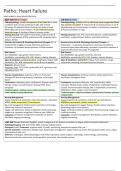Patho: Heart Failure
heart unable to pump blood effectively.
Right-Sided (Rest of body) Left-Sided (LUNGS)
Pathophysiology: usually consequence of left-sided HF or other Pathophysiology: inability of LV to effectively pump oxygenated blood
conditions that increase workload of right-side of heart into systemic circulation → reduced CO & increased pressure in LV →
RV pumps O2 depleted blood returning from body to lungs blood backing up into pulmonary circulation → pulmonary congestion
When right side of heart weakens → can’t effectively pump & fluid accumulation in lungs
blood into lungs → backlog of blood in venous system
Etiology (Causes): left-sided HF (specifically congestive HF) & Etiology (Causes): CAD, HTN, heart valve disease, cardiomyopathies,
chronic lung diseases (COPD, pulmonary HTN, congenital heart arrythmias, congenital heart defects, viral heart infections
defects, RV MI)
Anatomy (structural) & Physiology (function) Changes: RV → Anatomy (structural) & Physiology (function) Changes: LV
weakened RV struggles to pump blood into pulmonary dysfunction – LV becomes weakened or stuff reducing ability to
circulation → increased venous pressure → fluid retention contract & eject blood effectively; Increased LV pressure; backflow of
blood into left atrium into lungs → congestion
Risk Factors: Risk Factors:
Non-Modifiable: age, gender, family history Non-Modifiable: age, gender, family hx, ethnicity
Modifiable: uncontrolled HTN, CAD, tobacco, obesity, lifestyle Modifiable: uncontrolled HTN, CAD, diabetes, obesity, tobacco
Signs & Symptoms: peripheral edema, weight gain, fatigue, ABD Signs & Symptoms: SOB/SOBOE, fatigue, fluid retention, cough,
discomfort, JVD, SOB, tachycardia, nausea & loss of appetite tachycardia, wheezing, decreased exercise tolerance
Diagnosis: physical exam
Diagnostic Tests: CXR, ECHO, cardiac MRI, ECG, right heart cath
Laboratory Tests: BNP
Disease Complications: pulmonary HTN, Cor Pulmonale Disease Complications: pulmonary edema, kidney dysfunction,
(enlarged RV due to lung disease), arrythmias, multi-organ arrythmias, cardiogenic shock
failure
Treatments: Underlying cause; medications; lifestyle mods; O2 Treatments: medication (diuretics, ACE, beta blockers, ARBs,
therapy; cardiac resynchronization therapy (CRT), heart inotropic); lifestyle mods, cardiac rehabilitation, implantable devices
transplant (cardiac resynchronization therapy CRT or implantable cardioverter
Treatment goals - address cause, relieve symptoms, improve defibrillators ICDs), surgery, heart transplant
heart’s ability to pump effectively Treatment goals – reduce symptoms, improve heart function, prevent
complications
Nursing Management: Nursing Management:
Assess: Patient hx & symptoms; vitals; fluid balance; respiratory Assess: patient hx & symptoms; vitals & O2 sat; fluid balance;
status; cardiac assessment; PV assessment respiratory assessment; cardiac assessment
Do: med management; fluid & sodium restriction; O2 therapy, Do: med management; oxygen therapy; fluid & sodium retention;
positioning, monitor & document positioning (high or semi fowlers)
Teach: med adherence; dietary modification; fluid monitoring; Teach: medication; dietary modification; fluid monitoring; oxygen use,
oxygen use; symptom recognition; follow up care, DASH diet smoking cessation
Evaluation: symptoms management; fluid balance; patient Evaluation: symptom management; fluid balance; patient education;
education; ongoing monitoring ongoing monitoring
LABS: BNP (B-type Natriuretic Peptide): assists in diagnosis of HF; positive correlation to degree of left ventricular dysfunction.
Radiology/Imaging: CXR, ECG, ECHO, MIBI, Coronary Catheterization
Emergent (acute) Treatment: symptom relief, IV meds, monitoring, mechanical support (VAD, etc.)
Chronic treatment: medication, lifestyle mods, fluid/sodium management, regular follow-up, device therapy (pacemakers, etc), surgical
interventions (LVAD, etc.)
Referrals: cardiologist, electrophysiologist, heart failure specialist, cardiac surgeon, nephrology, endocrinology, pulmonology,
dietician/nutritionist, pharmacist, rehab specialist, social work, home health services
, Patho: COPD
Progressive, partially reversible airway obstruction & lung hyperinflation
Pathophysiology: Inflammatory response → bronchoconstriction, mucus production, damage to alveoli → structural changes like airway
remodeling, narrowing of bronchial tubes & emphysema → reduced airflow, increased resistance to breathing & difficulty exhaling
Etiology (Causes): long-term exposure to irritants with smoking being leading factor, can also include occupational exposures, pollution,
and genetic predisposition
Anatomy (structural) & Physiology (function) Changes:
• chronic inflammation & narrowing of airways → reduced oxygen exchange in lungs
• destruction of alveoli → decreased lung elasticity & impaired gas exchange
• chronic cough & mucus production are common due to increased production of mucus & decreased clearance
Risk Factors:
Non-Modifiable: genetics (hereditary); age (more common in older adults), infection, gender (males)
Modifiable: smoking; occupational exposures; air pollution; infections
Environmental: tobacco, occupational exposures, air pollution
Alpha 1 – antitrypsin deficiency; lungs lack this coating they are more exposed to damage by neutrophil elastase; it gets trapped in liver
causing damage
Signs & Symptoms: symptoms are often progressive & worsen over time
• chronic cough with or without mucus production
• SOB/SOBOE
• Wheezing
• Chest tightness
Diagnosis:
• Patient hx & symptom evaluation
• Spirometry (FEV1/FVC < 70%)
• Imaging – CXR or CT
• ABG analysis to evaluate oxygen & carbon dioxide levels
Disease Complications:
• Exacerbations – sustained worsening of dyspnea, cough, or sputum production → increased med use
• Acute respiratory failure
• Respiratory infections
• Cor Pulmonale – right sided HF (enlargement of right ventricle) due to pulmonary hypertension (high BP in lungs)
• Depression/anxiety/panic
• Malnutrition – difficulty eating & breathlessness → weight loss (small frequent meals high in protein & calories & low in carbs)
• Lung cancer
Treatments:
• Medication – bronchodilators, inhaled corticosteroids, combination inhalers, phosphodiesterase-4 inhibitors
• Oxygen therapy
• Pulmonary rehabilitation
• Lung volume reduction surgery
• Lung transplant
• Smoking cessation
• Vaccination
• Nutritional support
Nursing Management:
Assess: respiratory assess; oxygenation (SpO2); cough & sputum; activity tolerance, ABGs, CXR, ECG
Do: medication management; oxygen therapy (target 88-92%); breathing exercises (in nose 2 secs, out mouth 4 secs; diaphragmatic
breathing); cough & secretion management; positioning (high fowlers or tripod), smoking cessation, exercise (build up to 20 mins/day),
vaccinations (pneumococcal, influenza, covid), pulmonary rehab, manage anxiety/depression, drug therapy (bronchodilators &
corticosteroids)
Teach: medication education; symptom recognition; smoking cessation; lifestyle management
SOS for SOB – stop & rest in comfy position, get head down, get shoulders down, breathe in/out through mouth, breathe in & blow out
fast, blow out longer (use pursed lips if necessar7), slow breathing, begin to breathe in through nose, diaphragmatic breathing, stay in
position for 5 mins or longer
Evaluation: symptom management; medication adherence; self-care knowledge; oxygen therapy effectiveness; exacerbation prevention




